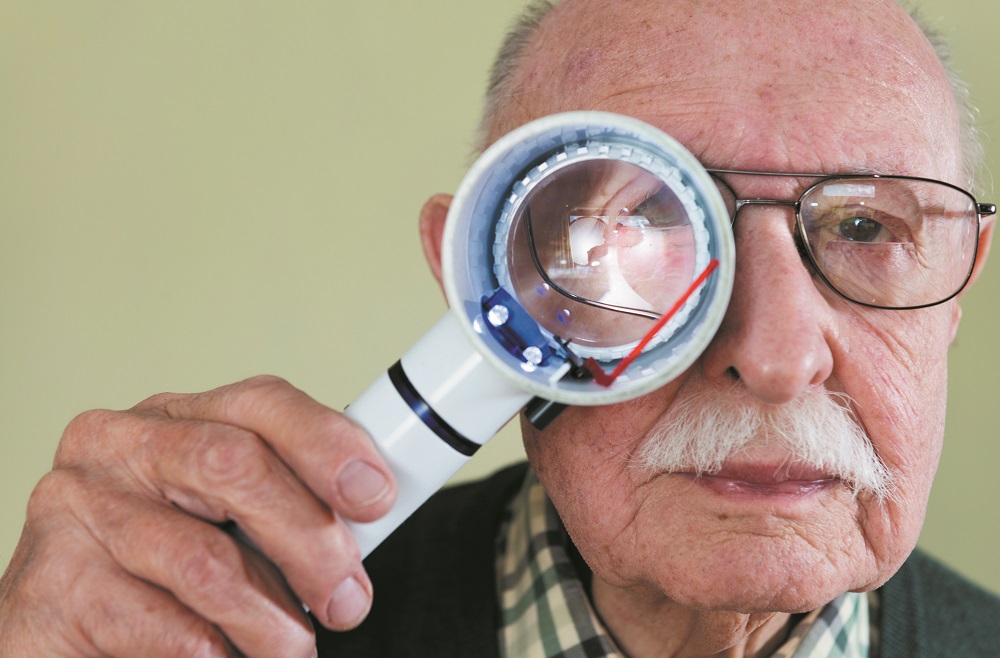Age-related macular degeneration (AMD) is more common than glaucoma and cataracts put together, and it’s the leading cause of vision loss in people over age 50. Once you have it, there is no cure, but you can take steps now to reduce your risk.
The macula is the central part of the retina at the back of the eye. Light-sensitive cells in your macula are responsible for central vision, what you see in front of your face. When your macula starts to degenerate, you begin to lose your central vision: what you need to drive, read, see faces, and work with your hands. AMD does not affect your peripheral vision, so you will not be completely blind, but loss of central vision is a handicap.
Controllable risk factors
The biggest risk factor for AMD, as you might expect from the name, is age. AMD starts to occur after age 50. After age 75, about one-third of people will have some amount of AMD.
Genes appear to play a role, too. Researchers estimate that 75 percent of people carry the genes for AMD, which can be passed down through families. But many people never get AMD, so we know that there are clearly other contributing factors. Controlling these is the key to reducing your chances of developing AMD:
- Quit smoking. If you smoke, you are up to five times more likely to get AMD.
- Exercise and maintain a healthy weight. Being obese doubles your risk of AMD.
- Get high blood sugar, high blood pressure, or high cholesterol under control.
- Wear sunglasses. There is some evidence that ultraviolet rays from the sun can cause AMD, especially if you have blue eyes. Sunglasses also reduce your risk of cataracts.
- Eat a healthy diet rich in antioxidants, such as leafy green vegetables and other colorful vegetables and fruits. Oxidative stress, which occurs when unstable molecules called free radicals damage cells, may play a role in causing AMD. Antioxidants capture these free radicals and prevent cell damage.
The role of supplements
Two National Eye Institute studies, called the Age-Related Eye Disease Studies (AREDS and AREDS2), found that high doses of antioxidant supplements could delay and possibly prevent the progression of AMD. The recommended supplements are vitamins C and E, the minerals zinc and copper, and the antioxidants lutein and zeaxanthin. These supplements are combined into a product called AREDS2 that you can get at drug or health food stores. The National Eye Institute recommends taking AREDS2 if you have intermediate AMD in one or both eyes to help slow down the vision loss.
Types of AMD
There are two types of AMD, and the cause and treatment for each type is different:
Dry AMD is the most common type. It happens when a type of protein builds up beneath the macula, causing the macula to become thin and dry. Symptoms of central vision loss are gradual, and complete loss of central vision rarely occurs. The only treatment for dry AMD is AREDS2. Treatment may slow down dry AMD, but it does not cure it.
Wet AMD is less common. In this type, abnormal blood vessels grow under the macula and leak, causing rapid degeneration of the macula and a rapid loss of vision. The main treatment for wet AMD is an injection of a substance called anti-vascular endothelial growth factor directly into the macula. This treatment may reduce the growth of the abnormal blood vessels or even stop the growth for a while, but the injections need to be repeated. Like dry AMD, wet AMD cannot be cured.
Regular checks lower risk
You can reduce your risk of AMD, but you can’t completely prevent it. That’s why the most important step is to get regular eye exams. The American Academy of Ophthalmology recommends a complete eye exam that includes looking at your retina and macula for everyone at age 40. If you are over age 65, you should get the exam every one or two years. An eye doctor can diagnose AMD before you have symptoms. Starting treatment at the early stage is your best bet for preventing the progression of AMD.


